Fracture Patterns on Metal Fracture Surfaces and Solutions for Problems in Metallurgical Failure Analysis
Metallic materials, which are used in a variety of products, are sure to break someday because of use or the surrounding environment. You can identify causes of breakage only after observing metallic materials and accurately analysing fractured surfaces (fractography).
In automotive, aerospace, and other industries where safety is important, the quality of materials is the basic concept regarding ensuring and improving the quality of products.
In this section, metallurgical failure analysis methods as well as features of fracture patterns and fractured surfaces are described. This section also introduces examples of using a 4K Digital Microscope to solve problems in metallurgical failure analysis.
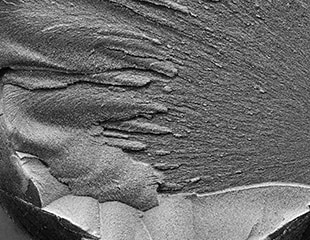
- Causes of Breakage Revealed by Metal Fracture Surfaces
- Types of Fractography
- Fracture Patterns of Metallic Materials
- Problems in Metallurgical Failure Analysis and Their Solutions
- Making Metallurgical Failure Analysis More Advanced and More Efficient
Causes of Breakage Revealed by Metal Fracture Surfaces
Metallic materials such as steel, copper, and aluminium alloy are used in a wide range of products, from home appliances and toys to infrastructure facilities and equipment.
Recently, in particular, new high-performance materials have been studied actively, mainly in the automotive and aerospace industries. These studies have become necessary due to requirements to reduce the size and weight and improve the rigidity of such materials all at the same time for the purposes of saving energy and reducing manufacturing and processing costs. In fields such as automobiles, airplanes, ships, railroad cars, and manned spaceships, breakage of metallic materials may put human lives at risk, so strict material selection and safety design based on strength calculation are required.
When selecting metallic materials, various material tests regarding the stress of such materials are conducted.
Typical test methods are as follows.
- Mechanical tests:
- Tension test, bending test, compression test, shearing test, creep test, wear test, etc.
- Hardness tests:
- Indentation hardness test, dynamic hardness test
- Chemical tests:
- Corrosion test
Through these material tests or structure observation (fractography) of metallic material surfaces fractured by use after being shipped as products, causes of breakage and basic properties of materials need to be examined to evaluate, select, or improve materials.
Types of Fractography
Fractography investigates how metallic materials have fractured (fractured surface pattern or fracture shape) through structure observation to estimate primary causes by considering various aspects such as materials, manufacturing methods, shapes, and use conditions. Among several methods for observing the structure of a fractured surface, the following are the main fractographic methods for metallic materials.
Macroscopic observation
Macroscopic observation is a method of analysis using, for example, the naked eye, low-magnification loupes, and stereoscopic microscopes. This observation can be conducted easily on the spot where a fracture has occurred and is used to roughly distinguish causes based on the type of the fracture, the presence of beach marks, and so on. However, macroscopic observation alone is not enough to investigate in detail how a fracture has occurred.
Microscopic observation
Microscopic observation investigates microscopic features by observing the structure of a fractured surface using, for example, optical microscopes and scanning electron microscopes (SEMs). With this observation, you can investigate fracture shapes in detail by capturing various features of a fractured surface such as dimples and striped patterns.
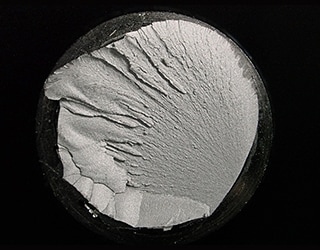
Fracture Patterns of Metallic Materials
Fracture patterns (fracture shapes) are classified into ductile (plasticity) fracture, brittle fracture, fatigue fracture, and environmental fracture. For each pattern, you can observe the features of a fractured surface through macroscopic observation and microscopic observation to investigate the cause of the breakage. The overview of each fracture pattern and the summary of its fractured surface are described below.
Ductile (plasticity) fracture
A ductile (plasticity) fracture is a fracture pattern observed in many metallic materials and shows large deformation such as stretching and necking up to the occurrence of the fracture. Through structure observation, you can see the following features and detailed fracture patterns.
- Features of fractured surfaces
-
- Macroscopic observation:
- Shear lip (shear fracture, end point of fracture), dull greyish white
- Microscopic observation:
- Isometric dimple (tensile fracture), stretched dimple (shear fracture), bent striped pattern (glide plane fracture)
Brittle fracture:
A brittle fracture is a fracture pattern in which cracking has rapidly spread while showing little plastic deformation. As cracking proceeds, no plastic deformation occurs around the fractured surface. In general, brittle fractures occur in many steel materials under normal use. In many cases, the fractured surface consists of quasi-cleavage fracture surfaces, which are observed on large heat-treated steel and general structural steel located in extremely cold environments.
- Features of fractured surfaces
-
- Macroscopic observation:
- Silver-white shining reflection, chevron pattern (rapid transgranular fracture), radially spreading cracks
- Microscopic observation:
- Quasi-cleavage fracture surface, river pattern, granular fracture, complex fracture
Fatigue fracture
A fatigue fracture is a fracture pattern in which cracking has gradually proceeded under repeated load. It is said that more than 70% of fracture patterns on mechanical structures fall under this pattern.
The appearance of the fractured material does not show stretching or necking, which is similar to brittle fractures, but significant plastic deformation is revealed under microscopic observation.
The fractured surface is generally smooth, compared to the surfaces of other fracture patterns, and beach marks (conchoidal patterns) are observed as a macroscopic feature. From the appearance of these beach marks, you can tell where the fracture started and in which direction the cracking proceeded.
As a microscopic feature, a striped pattern called striation is typically observed. This striped pattern is vertical to the direction in which the crack proceeded and is said to occur easily on aluminium alloys and copper alloys while not occurring easily on ferrous alloys.
- Features of fractured surfaces
-
- Macroscopic observation:
- Beach mark (conchoidal pattern), ratchet mark (several points of stress concentration), fish eye (start point of fracture), radially spreading cracks
- Microscopic observation:
- Striation (corresponding to the stress cycle), striation-like pattern (not corresponding to the stress cycle), secondary cracks, rub marks or fractures with no features
Environmental fracture
An environmental fracture is a fracture pattern that occurs with cracking developing under a corrosive environment. Therefore, this fracture may also occur even under an extremely small external stress.
Typical environmental fractures are hydrogen embrittlement and stress corrosion cracking.
- Hydrogen embrittlement
- Hydrogen embrittlement is also called a delayed fracture and is commonly observed on steel materials. This phenomenon (embrittlement) is caused by hydrogen entering into materials. This entry is typically observed in material manufacturing processes, such as welding and electroplating, and in corrosion reactions in the usage environment.
- Stress corrosion cracking
- This cracking often occurs in accidents in which austenite stainless steel is the material. In particular, transgranular fractures often occur in usage environments with C1- ions. On the other hand, grain boundary fractures occur in materials other than stainless steel such as pure copper, brass, and aluminium alloys.
- Features of fractured surfaces
-
- Hydrogen embrittlement
-
- Macroscopic analysis
- Silver-white shining reflection
- Microscopic analysis
- Granular fracture, hair mark
- Stress corrosion cracking
-
- Macroscopic analysis
- Partial reflection, rusting/discolouration
- Microscopic analysis
- Granular fracture, feathering pattern
- High-temperature fracture
-
- Macroscopic analysis
- —
- Microscopic analysis
- Granular fracture, dimple, sinkage
Problems in Metallurgical Failure Analysis and Their Solutions
As described above, by observing fractured surfaces not only through macroscopic observation but also through microscopic observation, you can investigate fracture patterns in more detail to understand the causes and conditions of fractures.
You can capture various fracture patterns with high definition to ensure more reliable fractography by using our 4K Digital Microscope that is based on state-of-the-art optical technology, an image sensor (CMOS), and image processing technology.
This section introduces metallurgical failure analysis examples using KEYENCE’s VHX Series ultra-high-definition 4K Digital Microscope.


Removing glare on a metal fracture surface
With the VHX Series 4K Digital Microscope
The glare removal function can suppress unnecessary reflection so that you can clearly capture even minute cracking on a metal fracture surface.
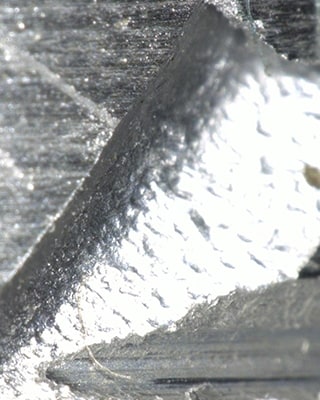

Fully focusing on the entire target even for uneven metal fracture surfaces
With the VHX Series 4K Digital Microscope
The real-time depth composition function makes it possible to bring an entire metal fracture surface into focus. This function not only reduces the time required for adjusting the focus repeatedly but also enables you to observe and evaluate many composite features that exist on a fractured surface.


Analysing details irrespective of angle and shadow
With the VHX Series 4K Digital Microscope
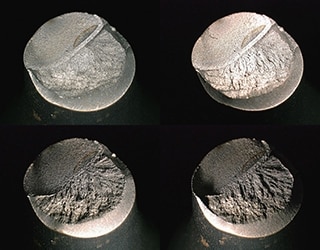
Using the multi-lighting function that automatically captures omnidirectional lighting data at just the push of a button, you can select the image that is most suitable for structure observation.
Even after you have selected or exported captured images, image data with each lighting condition is still saved on your PC. It is also possible to load an image with different lighting conditions simply by way of easy mouse operations.

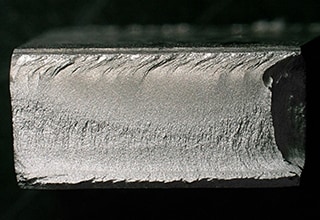
Clear observation even for minute shapes of subtle patterns
With the VHX Series 4K Digital Microscope
The Optical Shadow Effect Mode, a new observation method that combines a specifically designed high-resolution lens, a 4K CMOS image sensor, and lighting analyses the contrast in an image captured with varied illumination.
This method makes it possible to clearly observe subtle and minute irregularities on a metal fracture surface. Irregularity information can also be displayed in different colours by composing an Optical Shadow Effect Mode image with colour information.

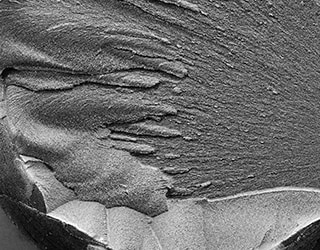
Making Metallurgical Failure Analysis More Advanced and More Efficient
As explained above, the VHX Series high-definition 4K Digital Microscope makes it possible to easily view metal fracture surfaces.
Because the VHX Series can reduce the time spent on metallurgical failure analysis, you can increase the speed of the quality improvement cycle and R&D. Also, the VHX Series enables you to retain image data in which the features of metal fracture surfaces have been captured accurately, so you can select and improve materials smoothly on the basis of past trends and comparisons.
Equipped with many other advanced functions, the VHX Series can be a powerful partner for more efficient fractography and structure observation, which are required to become a leader in the field of R&D. For details, click the button shown below to download the catalogue. For inquiries, click the other button shown below to contact KEYENCE.


